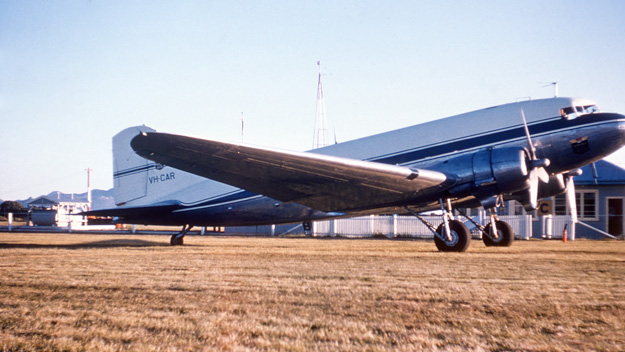
This aircraft (c/n 12874) was built to a US military order as a C47A-20-DK by the Douglas Aircraft
Company in Oklahoma City, USA, and allocated
the serial 42-93010, delivered on 28 March 1944. It was then transferred
to the RAAF in April of 1944 under lend/lease arrangements and allocated
the RAAF serial A65-46. It was also allocated the radio callsign VHCIC.
After wartime transport service, the aircraft was sold by the Commonwealth Disposals Commission to DCA on 26 October 1948. It underwent conversion to civil standards, officially becoming VH-JVF on 17 November 1949 and being named after former Minister for Air, the late James Valentine Fairbairn.
In December 1949 DCA received a set of Goodyear-designed cross-wind landing gear which was fitted to VH-CAR for trials. The equipment was expected to enable savings on the country aerodrome development programme which would cost £3-5 million for over 70 aerodromes as only one runway per aerodrome would need to be constructed. By December 1950, after six months of trials including flood rescue flights in NSW, it had been demonstrated that safe operation was possible in cross-winds above the normal limits for DC-3s. The cost of the equipment was approximately £5,000 per aircraft, compared with £75-100,00 for a runway. DC-3 runway criteria were used as the basis for all country aerodromes developed in the 1950-60 period. Despite the economic benefits VH-CAR was the only aircraft modified and was later converted back to standard configuration.
In line with the re-registration of all of DCAs DC-3s, VH-JVF officially became VH-CAR on 14 July 1950. It is seen in the photo above at DCA's main base at Melbourne/Essendon in 1954. Unusually it wears the DCA house colours of white fuselage top and light blue stripes, but does not carry the DCA badge which was usually to be found on the nose and fin. This may indicate that the aircraft had been recently re-painted.
In May of 1961 the aircraft was sold to Qantas, officially becoming VH-EDC on 7 June of that year. After a decade of service with Qantas it was sold and passed through a series of owners, finally coming to a watery end by ditching into Botany Bay, NSW, on 24 April 1994 following an engine failure on takeoff from Sydney/Kingsford Smith Airport en route to Norfolk Is. All 25 occupants successfully evacuated the aircraft before it sank.
The upper photo shows VH-CAR at an unknown country airport, probably in the 1960s, wearing DCA Flying Unit logos. The photo below shows it at Melbourne/Essendon in 1954 before the application of the DCA logos.
.jpg)
(Photos: 1-CAHS/Ben Dannecker collection; 2-Ed Coates collection)
Back to the main Departmental DC-3 index
If this page appears without menu bars at top and left, click
here